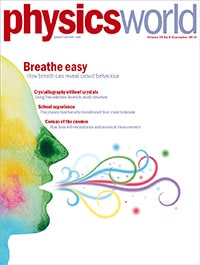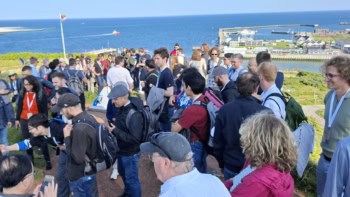The cover story in the September 2016 issue of Physics World magazine – now live in the Physics World app for mobile and desktop – reveals the fascinating new field of “crowd breath research”, which can even shed light on how cinema audiences react during the changing scenes in a movie. You can read the article here on physicsworld.com too.
The September issue also shows how to do crystallography without crystals, explains how first data from the Gaia spacecraft could revolutionize astronomy (see the above video for more on that), and contains one physics teacher’s fascinating story about what she did to change her school’s gender balance.
Don’t miss either reader feedback on the potential impact of Britain leaving the EU on physics or Robert P Crease’s Critical Point column on why science denial is one of the most important issues in the US presidential campaign.
If you’re a member of the Institute of Physics (IOP), you can now enjoy immediate access to the new issue with the digital edition of the magazine in your web browser or on any iOS or Android mobile device (just download the Physics World app from the App Store or Google Play). If you’re not yet in the IOP, you can join as an IOPimember for just £15, €20 or $25 a year to get full access to Physics World digital.
 For the record, here’s a run-down of what else is in the issue.
For the record, here’s a run-down of what else is in the issue.
• New era for quantum space science – China has launched a probe to test the feasibility of quantum communication between ground and space, as Ling Xin reports
• Turkish science reels from travel ban – A failed coup by a faction of the Turkish military in July has resulted in the government imposing restrictions on researchers, as Michael Banks reports
• How YouTube can inspire – Ansh Bhatnagar says that online videos about physics could play an important part in inspiring the next generation of scientists
• Fighting science denial – Ahead of this autumn’s US presidential election, Robert P Crease proposes five ways to encourage a responsible discussion of scientific issues
• Every breath we take – Research from a cinema in Germany shows how the breath of a crowd can reflect how they’re feeling, as Stephen Ornes reports
• A billion pixels, a billion stars – The Gaia spacecraft is conducting the most ambitious and thorough census of our galaxy ever attempted, gathering data on 100,000 stars every hour. With the mission’s first major data release due this month, Gerry Gilmore and Floor van Leeuwen explain how the spacecraft works and assess its likely impact on the field of astrophysics
• Diffract, then destroy – A new implementation of X-ray diffraction using free-electron lasers can take snapshots of biological molecules that are inaccessible via X-ray crystallography. As Philip Ball reports, the technique can even be used to create stop-motion films of dynamic molecular processes
• Adventures in search of auroras – Colin Forsyth reviews Aurora: In Search of the Northern Lights by Melanie Windridge
• The risks and rewards of radiation – Jun Deng reviews Strange Glow: the Story of Radiation by Timothy Jorgensen
• A conference of our own – Setting up a brand-new student-run conference isn’t easy, but for Adam O’Connell and Reaal Khalil, it was an opportunity to develop skills that a standard physics degree course just doesn’t provide.
• Once a physicist – Ruth Itzhaki is professor emerita of molecular neurobiology at the University of Manchester and honorary senior research fellow at the University of Oxford, UK
• Gender balance, one woman at a time – Debbie Hayton on her experiences as a physics teacher after transitioning from male to female



